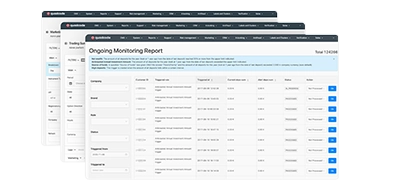Back
Contents
Exit Liquidity – What Is It? How It Works?

Demetris Makrides
Senior Business Development Manager

Vitaly Makarenko
Chief Commercial Officer
What is Exit Liquidity?
Exit liquidity is the ability of the market to take in sell orders without affecting the asset’s price too much. In other words, it is your potential to sell your assets back into cash (or some other currency) without inducing a precipitous price decline.
When you choose to liquidate your investment, especially a significant holding, you need enough buyers willing to purchase at or very near your expected price. These buyers collectively provide the “exit liquidity” that allows you to exit your position smoothly.
Exit liquidity assumes a special role in cryptocurrency markets due to the relative maturity and volatility of the market compared to other traditional financial markets. Several cryptocurrencies, especially newer or smaller-cap tokens, suffer from liquidity problems that make it challenging for them or expensive to achieve large exits.
What are the Types of Exit Liquidity?
Exit liquidity manifests in different forms across markets:
Natural Market Liquidity
This comes from organic trading activity where numerous market participants are actively buying and selling. Established cryptocurrencies like Bitcoin and Ethereum typically have robust natural liquidity.
Market Makers
Professional traders or firms that provide liquidity by maintaining continuous buy and sell orders, narrowing spreads, and facilitating trades. They’re essential in maintaining healthy markets.
Liquidity Pools
Smart contract-based mechanisms in DeFi, where users lock assets in pools to facilitate trading. These pools allow traders to enter and exit positions with minimal slippage in a trustless environment.
Retail Investors
Often, the most vulnerable form of exit liquidity, retail investors sometimes serve as exit liquidity for larger players or project insiders, particularly in schemes designed to exploit them.
What is the Significance of Exit Liquidity in Trading and Investing?
Exit liquidity impacts your trading and investment experience in several ways:
- Slippage Control: Sufficient exit liquidity means you can sell without excessive slippage (the difference between the expected and executed price).
- Risk Management: Understanding liquidity helps you size positions appropriately to the market’s depth.
- Project Evaluation: A project’s liquidity profile can signal its legitimacy and sustainability.
- Exit Strategy Planning: Realistic exit plans must consider the available liquidity for your assets.
How Exit Liquidity Works
Mechanics in Different Markets
In traditional securities markets, exit liquidity is provided through established exchanges with deep order books, market makers, and institutional participation. These structures ensure relatively stable liquidity under normal conditions.
In cryptocurrency markets, exit liquidity works differently:
- Exchange-Based Trading: Centralized exchanges provide liquidity through order books where buyers and sellers are matched.
- Decentralized Exchanges (DEXs): Liquidity is provided through automated market makers (AMMs) and liquidity pools rather than traditional order books.
- Over-The-Counter (OTC): Large trades often occur off-exchange to prevent market disruption, with specialized desks matching big buyers and sellers.
Market Depth and Liquidity Pools
Market depth represents the market’s ability to sustain large orders without significant price impact. You can visualize it through order books, showing pending buy and sell orders at different price levels.
In DeFi, liquidity pools have revolutionized how exit liquidity functions:
- Liquidity providers deposit equal values of two assets into a pool
- Smart contracts automatically price assets using mathematical formulas (like x*y=k)
- Traders can swap against these pools, with larger trades causing a more significant price impact
- Liquidity providers earn fees from trades
While innovative, these pools can sometimes mask liquidity problems. A pool might show a large total value locked (TVL) but still experience significant slippage for larger trades if the pool is imbalanced.
Impact on Price Action
When exit liquidity is insufficient relative to selling pressure, prices can collapse rapidly. This dynamic creates several market phenomena:
- Slippage: Large sell orders “eat through” available buy orders, resulting in progressively worse prices as the order executes.
- Cascading Liquidations: In leveraged markets, price drops can trigger forced liquidations, creating more selling pressure and further price declines.
- Exit Scams: In manipulated markets, orchestrated pump-and-dump schemes rely on retail traders providing exit liquidity for insiders who sell at inflated prices.
Signs of Exit Liquidity Issues
Warning Signs in Projects
You should be alert to several red flags that might indicate exit liquidity problems or potential scams:
- Locked Tokens: Large percentages of supply controlled by founders or insiders with unclear or short vesting periods
- Limited Exchange Listings: Tokens available only on obscure or single exchanges
- One-Way Price Movement: Suspicious patterns where buying seems easy but selling is difficult
- Marketing Focus: Excessive emphasis on price appreciation rather than technology or utility
- Restricted Withdrawals: Exchanges or projects implementing sudden withdrawal limitations
Market Indicators
Technical indicators can help identify potential liquidity problems:
- Bid-Ask Spread: Wider spreads indicate thinner liquidity
- Order Book Depth: Shallow order books suggest limited exit liquidity
- Volume Profile: Low volume relative to the market cap can signal liquidity issues
- Liquidity Ratios: Metrics comparing daily trading volume to market capitalization
- Unusual Volume Spikes: Sudden volume increases without clear catalysts may indicate manipulation
Examples of Exit Liquidity Issues
The cryptocurrency space has witnessed numerous instances where exit liquidity played a central role:
- BitConnect (2018): This notorious Ponzi scheme collapsed when withdrawals exceeded new investments, revealing the absence of genuine exit liquidity.
- LUNA/UST Crash (2022): As UST depegged, exit liquidity evaporated rapidly, leading to a death spiral as investors rushed to exit simultaneously.
- Numerous Small Cap Tokens: Countless smaller projects have followed similar patterns – rapid price appreciation followed by liquidity crises when early investors attempt to exit.
Exit Liquidity Strategies
For Traders and Investors
Navigating exit liquidity requires thoughtful strategies:
- Position Sizing: Align your position size with available market liquidity. The larger your position relative to daily volume, the harder a clean exit becomes.
- Staged Exits: Rather than selling your entire position at once, consider dividing it into smaller portions and selling gradually over time.
- Liquidity Analysis: Before investing, assess whether the market can reasonably absorb your eventual exit at the scale you’re planning.
- Stop-Loss Management: In thin markets, traditional stop-loss orders may experience significant slippage. Consider using more conservative stop levels or time-weighted exit algorithms.
- Exchange Selection: Different exchanges offer varying liquidity profiles for the same asset. Research where your asset has the deepest markets.
For Project Developers
Legitimate projects must consider exit liquidity as part of responsible tokenomics:
- Liquidity Mining Programs: Incentivize community members to provide balanced liquidity pairs.
- Strategic Reserve Management: Maintain project treasuries to support liquidity during market stress.
- Transparent Vesting: Implement reasonable vesting schedules for team and investor tokens to prevent market flooding.
- Market Maker Relationships: Engage professional market makers to ensure consistent two-way markets.
Ethical Considerations for Exit Liquidity
The concept of exit liquidity raises important ethical questions:
Zero-Sum Dynamics
In some contexts, your profitable exit requires someone else to buy at what may become a losing position.
Information Asymmetry
Projects often have better information than retail investors about upcoming events affecting liquidity.
Community Responsibility
Project founders have ethical obligations regarding how they manage token distributions and liquidity.
Risks with Exit Liquidity
Rug Pulls and Scams
“Rug pulls” represent the most notorious abuse of exit liquidity in crypto markets. These scams typically follow a pattern:
- Developers launch a token with limited initial liquidity
- Aggressive marketing drives retail investment, pushing prices higher
- Developers and insiders sell their holdings into this retail liquidity
- The project team removes the remaining liquidity, leaving investors with worthless tokens
This process essentially uses retail investors as exit liquidity for insiders. The name comes from the expression “pulling the rug out” from under someone.
Market Manipulation Tactics
Several tactics manipulate exit liquidity:
- Wash Trading: Creating artificial volume through self-trading to give the impression of liquidity where little exists.
- Liquidity Pumping: Temporarily adding liquidity during marketing phases, then removing it once sufficient investor funds have entered.
- Honeypot Tokens: Smart contracts specifically designed to allow buying but prevent selling for most users.
- Spoofing: Placing and quickly canceling large orders to create the illusion of market depth.
How to Identify Potential Scams
To protect yourself, learn to recognize warning signals:
- Too-Good-To-Be-True Returns: Promises of guaranteed outsized returns are major red flags
- Anonymous Teams: Projects with unverified or pseudonymous founders carry additional risk
- Smart Contract Issues: Lack of audits or contracts that give developers special privileges
- Centralized Liquidity Control: Projects where developers maintain control over the majority of liquidity
- Aggressive Marketing: Heavy promotion with little substance often masks liquidity issues
How to Protect Yourself from Loss with Exit Liquidity
Due Diligence Strategies
Before investing, conduct thorough research:
- Token Distribution Analysis: Examine how tokens are distributed. Healthy projects typically have diverse holder bases without excessive concentration.
- Liquidity Examination: Verify the depth and breadth of liquidity across exchanges. Check whether liquidity provider (LP) tokens are locked or burned.
- Smart Contract Verification: For DeFi investments, review smart contract audits and check for potential vulnerabilities.
- Team Background Checks: Research the team’s history, previous projects, and reputation in the community.
- Social Sentiment Analysis: Monitor community discussions for red flags or shifting sentiment patterns.
Risk Management Approaches
Even with careful research, risk management remains essential:
- Portfolio Diversification: Don’t concentrate on investments in illiquid assets
- Position Sizing: Size investments according to liquidity constraints
- Exit Planning: Develop clear exit strategies before investing
- Profit Taking: Consider securing partial profits during strong uptrends
Tools and Resources
Several tools can help assess liquidity risks:
- DEX Screeners: Platforms like Dextools or Dex Screener provide liquidity and trading data
- Blockchain Explorers: Tools like Etherscan allow you to examine token contracts and holder distributions
- Liquidity Analysis Tools: Services that track liquidity metrics and unusual movements
- On-Chain Analytics: Platforms that monitor large holder behaviors and token flows
The Future of Liquidity in Crypto
Evolving Mechanisms
The cryptocurrency space continues to innovate around liquidity challenges:
- Concentrated Liquidity: Protocols like Uniswap v3 allow liquidity providers to focus capital in specific price ranges, potentially improving capital efficiency.
- Protocol-Owned Liquidity: Projects like Olympus pioneered models where protocols themselves own liquidity rather than renting it through incentives.
- Cross-Chain Liquidity: Solutions enabling liquidity to flow seamlessly across different blockchains.
- Layer-2 Solutions: Scaling technologies that reduce transaction costs and improve trading efficiency.
Regulatory Considerations
Regulation increasingly affects liquidity in cryptocurrency markets:
- Potential requirements for stricter KYC/AML compliance by liquidity providers
- Possible regulation of DeFi liquidity mechanisms
- Legal frameworks addressing market manipulation tactics
Regulatory clarity might ultimately strengthen sustainable liquidity by removing some forms of manipulation.
Technological Innovations
Looking ahead, several innovations may transform crypto liquidity:
- AI-Powered Liquidity Analysis: Advanced tools to identify liquidity risks
- Orderbook/AMM Hybrids: New market structures combining the benefits of different models
- Privacy-Preserving Liquidity: Solutions allowing compliant liquidity while preserving user privacy
- Real-World Asset Tokenization: Bringing traditional assets on-chain could dramatically deepen crypto liquidity
Conclusion
As we’ve explored throughout this article, exit liquidity represents a fundamental concept that affects every participant in cryptocurrency markets. Understanding it helps you make more informed investment decisions and protect yourself from potential scams.
Whether you’re a trader, investor, or project developer, incorporating an understanding of exit liquidity into your strategy can help you navigate the complex and sometimes treacherous waters of cryptocurrency markets.
FAQ
Exit liquidity is the market's capacity to absorb sell orders without impacting the asset's price too significantly. It's actually the buying power in the market to enable you to sell your assets and "exit" your position at a reasonable price. Good exit liquidity is the capacity to sell your assets without lowering the price significantly.
In cryptocurrency markets, liquidity is a gauge of how fast you can sell a cryptocurrency asset for money or another cryptocurrency without affecting its price. Healthy liquidity means assets can be bought or sold with minimal price influence within a short horizon. Low liquidity tends to lead to greater volatility, wider bid-ask spreads, and greater slippage when trading. Liquidity is essential for market stability, fair price discovery, and efficient trading. Bad crypto liquidity often is a harbinger of manipulation risk and may prevent big investors from being able to get in or out of positions adequately.
Good crypto liquidity can be seen by a number of important indicators: Low bid-ask spreads (ideally below 1%); High daily trading volume per market capitalization (min. 5-10% or better); Deep order books that will absorb big trades; High frequency of trading across several exchanges; Low price effect when ordering relatively small amounts; Uniform liquidity values even during times of market stress. Long-standing cryptocurrencies like Bitcoin and Ethereum tend to have positive liquidity characteristics, while newer or niche tokens are marred by problems of liquidity.
Updated:
April 25, 2025
19 December, 2025
Top 10 White Label Casino Providers 2026
A white label casino is a ready-made online gambling platform that lets entrepreneurs start their own brand without building technology or securing licenses from scratch. In 2026, this model remains the fastest and most affordable way to enter the iGaming market. The leading white label casino providers in 2026 are SoftSwiss, BetConstruct, NuxGame, SoftGamings, FintechFuel, […]




